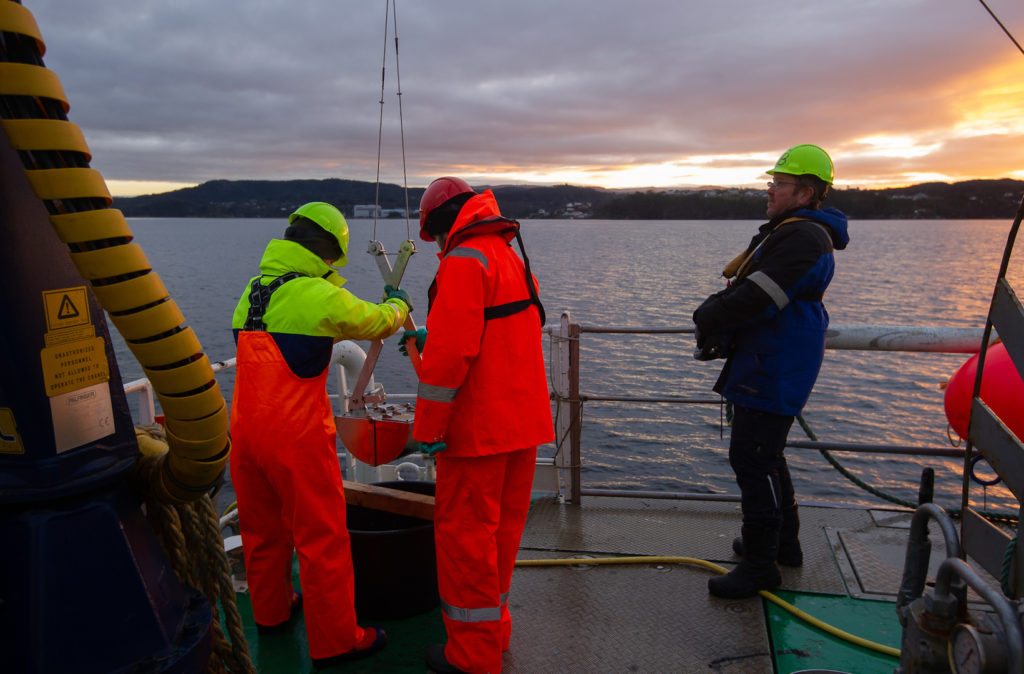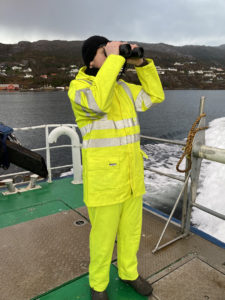Last days of November HYPCOP spend two days (26th & 27th) offshore. We had the possibility to join some sampling efforts of NorHydro and others on the research vessel Hans Brattström.
This vessel is owned by the University of Bergen and operated by the institute of Marine Research (IMR, Havforskningsinstituttet).
H. Brattström is used 200 – 230 days a year along the West coast of Norway. It has the capability of operating different sampling gear, which makes it useful for multiple projects, studying a variety of marine organisms, from fish, to worms, jellyfish, and yes, also copepods!
On the first day HYPCOP joined NorHydro consisting of Luis Martell (UiB) and Joan Soto Angel (Sars):
The main sampling gear consisted of a large plankton net that was slowly dropped to 660m, 245m and 128m depth. We sampled close to Bergen in Raunefjord, Krossfjord and Fanafjord.
Sampling for jellyfish needs to be done with caution, with the net going up to fast, the animals will just fall apart because of the pressure. So, a depth of 660m can take up to an hour and more before we could see the results.
During the waiting times we didn’t let our time go to waist, with binoculars we scanned the air and shore for birds.
After waiting for some time, the plankton net was brought back on board and contained, besides jellyfish and other pelagic planktonic dwellers, many million copepods. Mostly consisting of a few species. One of the species had a distinguishable blue egg sack, this is Paraeuchaeta norvegica (Boeck, 1872). This species is an active predator that feeds on other (smaller) copepods by rapidly jumping on them and catching their prey with their large maxillipeds (mouthparts).
- A jar full with copepods, photo Cessa Rauch
- Paraeuchaeta norvegica, photo Cessa Rauch
The second day HYPCOP joined head engineer Bjørn Reidar Olsson (UiB) and PhD student Miguel Meca (UiB)
They were looking for shark teeth and polychaetes (marine worms) respectively and used the grab, which is perfect for benthic copepod sampling. The grab is basically a big metal clamshell that collects sediment from the seafloor. Working with grab samples gets dirty very quickly, you have to wash through the sediment to find your animals.

The grab with Cessa Rauch (HYPCOP left), Miguel Meca (middle) plus operator Bjørn Frode Grønevik (right), photo Bjørn R. Olsson
- Miguel Meca (left) and Bjørn Olsson (right) sieving sediment looking for shark teeth and worms, photo Cessa Rauch
- Miguel Meca fixating his samples, photo Bjørn R. Olsson
Most of the sediment was filtered out in order to find our copepod friends. Although less plentiful in comparison to the plankton net sampling the previous day, we still found some copepods hiding in the dirt. At moment of this writing, the the copepod species we collected have not be named yet, however, the last months we have been experimenting with barcoding the first batch of 60 different specimens. We had a 43% success rate. Usually, marine invertebrates have a success rate between 40 – 70%, so it was still within the margin, but not with a lot of enthusiasm. HYPCOP will spend the remainder of 2020 and the beginning of 2021 in the laboratory figuring out what the culprit of this low success rate could be.
For HYPCOP this will be the last blog before the Christmas holidays and the New Year. Therefore, we want to take the opportunity to wish you happy holidays and hope to see you around in 2021 with from us more copepod news to share!
-Cessa
Follow HYPCOP @planetcopepod
Instagram, for pretty copepod pictures https://www.instagram.com/planetcopepod/
Twitter, for copepod science news https://twitter.com/planetcopepod
Facebook, for copepod discussions https://www.facebook.com/groups/planetcopepod
See you there!









